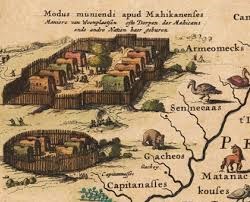
New Netherland Institute Dutch Arrive in Hudson River ValleyWhen Dutch traders and settlers began to arrive in the Hudson River Valley in the early seventeenth century, they encountered people who had been living - and farming – in the region for many centuries. The area that later became Columbia County was part of the territorial homelands of the Muhheconneok[1] people, an Algonquian speaking group that combined hunting and gathering with cultivation of crops. There were an estimated two to three thousand people before the contact period, a number that was already dropping by the time of Henry Hudson’s 1609 voyage due to the effects of new diseases that arrived with Europeans. 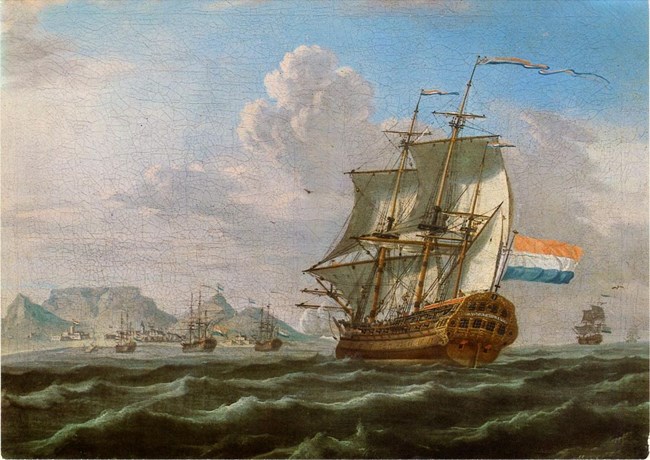
Anonymous_The_Noord-Nieuwland_in_Table_Bay,_1762 Dutch ColonistsDutch colonists first established a presence in the Hudson Valley in the early seventeenth century. By mid-century, a varied population of settlers had come to the area under the auspices of the Dutch West India Company who had created the New Netherland colony. By the 1650s a family had purchased a piece of land in “Beverwyck” (modern Albany.) In 1671, they acquired a tract on the west side of the Kinderhook Creek, vaguely designated as “behind Kinderhook.” In the same period, two brothers from the Van Alen family, Pieter and Lourens, acquired land on the other side of the creek and established a farm. Sometime before 1674, Pieter Van Alen sold some of his land to Lambert Van Alstyne. Lambert established a farm there – the first European farmstead on the property that would later become Lindenwald. The Van Alstynes, Van Alens, and other Dutch settlers formed a close-knit core in the town of Kinderhook for well over two centuries, and many of their descendants remain in the area today.The Van Ness FamilyPeter Van Ness, a Senator, Justice of the Peace, and Chief Judge of the Court of Common Pleas, acquired 260 acres from William and Lambert Van Alstyne sometime before 1787. This property included a stone house down on the flats, farmland along Kinderhook Creek, and some land on the eastern side of the Post Road. (The “Post Road” started as a local road between the Van Alstyne house and the Kinderhook Creek. It was moved to the upper terrace where it became part of a major New York-to-Albany road. The local portion was then moved again to the western side of the creek. This being a “new” road, the upper terrace road became referred to as the “Old Post Road” as it is known today.) Van Ness moved into the stone house and named the Van Alstyne property “Kleinrood” (Little Red.) Around 1797, he built a new brick house on the upper terrace facing the “Old Post Road.” His household included his wife, three sons, two daughters, and ten enslaved Africans.
NPS Image Van BurenWhen Martin Van Buren was defeated in his bid for reelection to the presidency, he came home to Kinderhook and, like Washington and Jefferson before him, devoted himself to farming. At Lindenwald, Van Buren was at once an elder statesman, leading a genteel life on his country estate, and a farmer, engaged in agrarian pursuits side by side with his “common” peers in rural Kinderhook. He was glad to be home, and the farm had been kept in good condition by Harder. Within four years, he brought the size of the farm to two hundred and twenty acres. He improved the grounds, planted extensive orchards, and cultivated a large garden with a greenhouse, grapes, and other fruit. He constructed barns, sheds, and other buildings behind the mansion. While he had some livestock: sheep, fowl, milk cows, hogs, and horses, he focused largely on crop production, primarily grains (hay, oats, rye) and potatoes. Fifteen acres were devoted to a woodlot for fuel and building. His day began with a ride (on his horse, Duroc) of up to 15 miles around the estate and into town. After breakfast, he worked the fields before retiring to the library to read and write letters. Every Sunday he was in the Dutch Reformed Church family pew.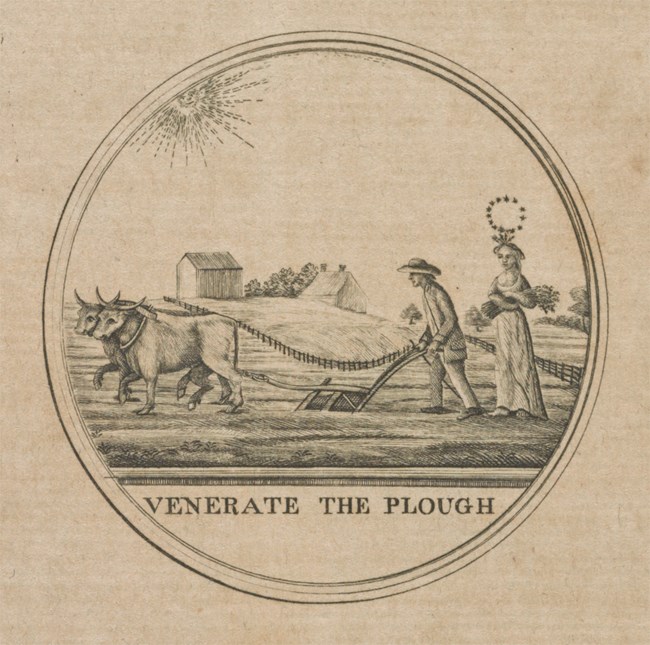
Courtesy of Annenberg Rare Book and Manuscript Library: Van Pelt-Dietrich library Center. University of Pennsylvania. Van Buren as a FarmerHe was a very serious farmer who saw his farm as an expression of his political and personal values. He shared the Jeffersonian and Jacksonian belief in farmers as the backbone of American democracy and economic health. Being engaged in common agrarian pursuits had positive connotations in Van Buren’s day. Agriculture was mythologized as a noble, patriotic occupation. Agricultural reformers extolled the virtues of farming, not only as “the principal source of our wealth” but more importantly, as “the parent of physical and moral health to the state” and a means to “perpetuate the republican habits and good order of society.” Farmers relied on their own hard work for success and were free of the taint of corruption.Although Van Buren relied almost entirely on hired labor or tenent farmers for the actual work of cultivation, there is no doubt that he was thoroughly engaged in his farming venture and quite successful at it, providing much of the food for his own household and producing surpluses and commercial crops that eventually made the farm at least somewhat profitable. It was a pleasant, comfortable life, and with personal property and real estate worth as much as $200,000, Van Buren could well afford to live the life of a country gentleman. He clearly did not, however, embrace commercial farming to the extent that other comparable farmers in the area did, and it seems possible that, as has been conjectured, "for all its owner’s obsession with profitability, Lindenwald was more an aging gentleman’s fancy than a viable business enterprise." The Lindenwald estate did not necessarily reflect a "working-class" lifestyle. Van Buren, despite the ongoing depression, was well off financially. He owned a good many books, and spent $50-75 a year to acquire others. In the evening, he entertained so often that it seemed to Silas Wright always to be "open house." Van Buren loved rich food and drink and spent more on butter than on taxes and church. An Englishwoman who visited Van Buren at Lindenwald in 1846 claimed that the estate was fit for British gentry. She wrote, "The comforts and elegancies of his residence exactly resemble those we find in the country house of an English gentleman of fortune who lives upon his estate." 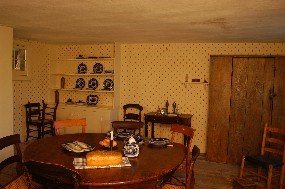
NPS Image Life at LindenwaldVan Buren maintained a household staff of six who received wages plus room and board. It was comprised of wives and daughters of farmhands, some seasonal help, and Irish immigrant women. His chef, Felix, was paid $12.00 per month, as was the coachman. The butler and the valet, who both doubled as waiters, each received $8.00 per month. Two household maids each received $6.00 per month. He allocated a sum of $200.00 over a six-month period for farm and garden help wages, and an annual outlay for household servants of $640.00 per annum. Almost as soon as he arrived home from Washington, visitors started to arrive, some for a day and others for a week or two. His guests included: Thomas H. Benton, Francis Blair, the Earl of Carlisle, Henry Clay, Washington Irving, Winfield Scott, Charles Sumner, David Wilmot, and Silas Wright. The Main Hall at Lindenwald is perhaps the most important room in the house. It is commonly believed that Van Buren used it as a large dining space. Some considered it "the center of what was essentially a ‘government in exile.’" Serving styles for formal dinners went in and out of fashion, and Van Buren always followed the latest trends. He is documented as having owned green glass fingerbowls, which had become fashionable during his presidency. Thomas Hart Benton, a dinner guest, was once confronted with the unfamiliar bowls. He remarked: "I am rather chary of new customs, but after noticing Mr. Van Buren dip the tips of his fingers in the bowl and wipe them daintily on his napkin, I just raked back my cuffs and took a good plain republican bath." Van Buren’s four sons had worked for the president in Washington, DC. Now back in Kinderhook, they were happy to be living with him, or at least nearby. Abraham, the oldest son, and his wife, Angelica, had their first child and were living in a Stuyvesant cottage. In June of 1841, John married Elizabeth Vanderpoel, and in 1842, Smith married Ellen James. The three had presented the president with his first three grandchildren, while Martin Junior would become a permanent resident at Lindenwald suffering from consumption. 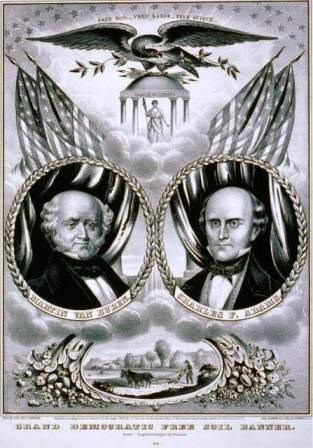
NPS Image After the loss of the nomination of the Democratic Party, Van Buren wrote that his second retirement had reduced neither the “happiness nor the cheerfulness at Lindenwald.” Once again seeking a “life of quiet contentment” he sank himself into the responsibilities of the farm, occasionally going fishing with family or colleagues. His four sons were still a part of his life, and he remained always aware of state affairs. As John Van Buren was finding his own place in New York government and national politics, Van Buren began to realize that he missed the challenge of being in national leadership. It was John’s involvement in the beginning of the anti-slavery movement that would bring Martin Van Buren onto the political stage once more. In an effort to affect the state of slavery in the growing United States, Van Buren lent his name to the Free-Soil party to once again be a candidate for president. His election to office was not to be, but the influence of the party began the painful process of bringing the needed changes to a country that could not find a peaceful resolution to its divisiveness. 
NPS Image After John Van Buren sold Lindenwald, 110 years passed before the National Park Service acquired the estate to preserve the memory of President Martin Van Buren and the “Antebellum” period of our history. People of many backgrounds, some of them farmers, some of other backgrounds would call Lindenwald home. Since 1974, the National Park Service has taken people back to that time of family joy amongst national division and strife. Hopefully, we have learned the lessons of the past and continue to learn from the President who lived in the little Dutch village in the Hudson River Valley. |
Last updated: September 19, 2022
